MGT5ARP La Trobe: O'Meara Electronics Remuneration & Performance
VerifiedAdded on 2023/06/12
|10
|2629
|291
Case Study
AI Summary
This case study delves into the declining market position and profitability of O'Meara Electronics, an Australian company with international subsidiaries. It identifies issues within the company's performance management and remuneration systems, particularly the focus on customer contracts over employee performance, inadequate team management, and resistance to change. The report explores new performance management strategies such as Management by Objectives (MBO) and 360-degree appraisal, comparing their effectiveness. It also discusses position-based and person-based remuneration systems, recommending a hybrid approach for O'Meara Electronics that links rewards to performance and combines elements of both systems to motivate employees and align individual goals with organizational objectives. The ultimate goal is to enhance employee engagement, improve performance, and drive the company towards achieving its objectives.

ADVANCED REMUNERATION AND
PERFORMANCE – 713761
PERFORMANCE – 713761
Paraphrase This Document
Need a fresh take? Get an instant paraphrase of this document with our AI Paraphraser
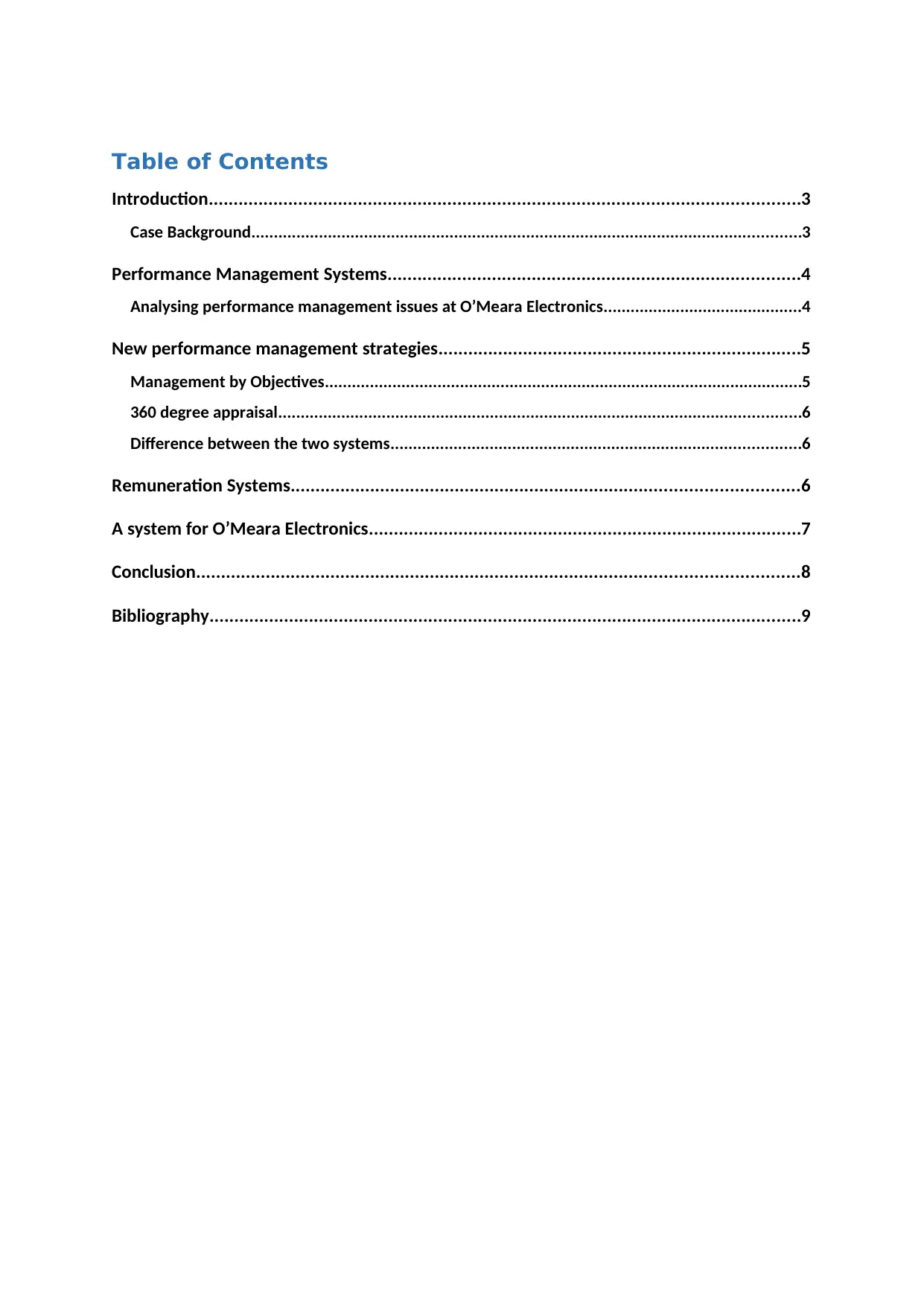
Table of Contents
Introduction.......................................................................................................................3
Case Background..........................................................................................................................3
Performance Management Systems...................................................................................4
Analysing performance management issues at O’Meara Electronics............................................4
New performance management strategies.........................................................................5
Management by Objectives..........................................................................................................5
360 degree appraisal....................................................................................................................6
Difference between the two systems...........................................................................................6
Remuneration Systems......................................................................................................6
A system for O’Meara Electronics.......................................................................................7
Conclusion.........................................................................................................................8
Bibliography.......................................................................................................................9
Introduction.......................................................................................................................3
Case Background..........................................................................................................................3
Performance Management Systems...................................................................................4
Analysing performance management issues at O’Meara Electronics............................................4
New performance management strategies.........................................................................5
Management by Objectives..........................................................................................................5
360 degree appraisal....................................................................................................................6
Difference between the two systems...........................................................................................6
Remuneration Systems......................................................................................................6
A system for O’Meara Electronics.......................................................................................7
Conclusion.........................................................................................................................8
Bibliography.......................................................................................................................9
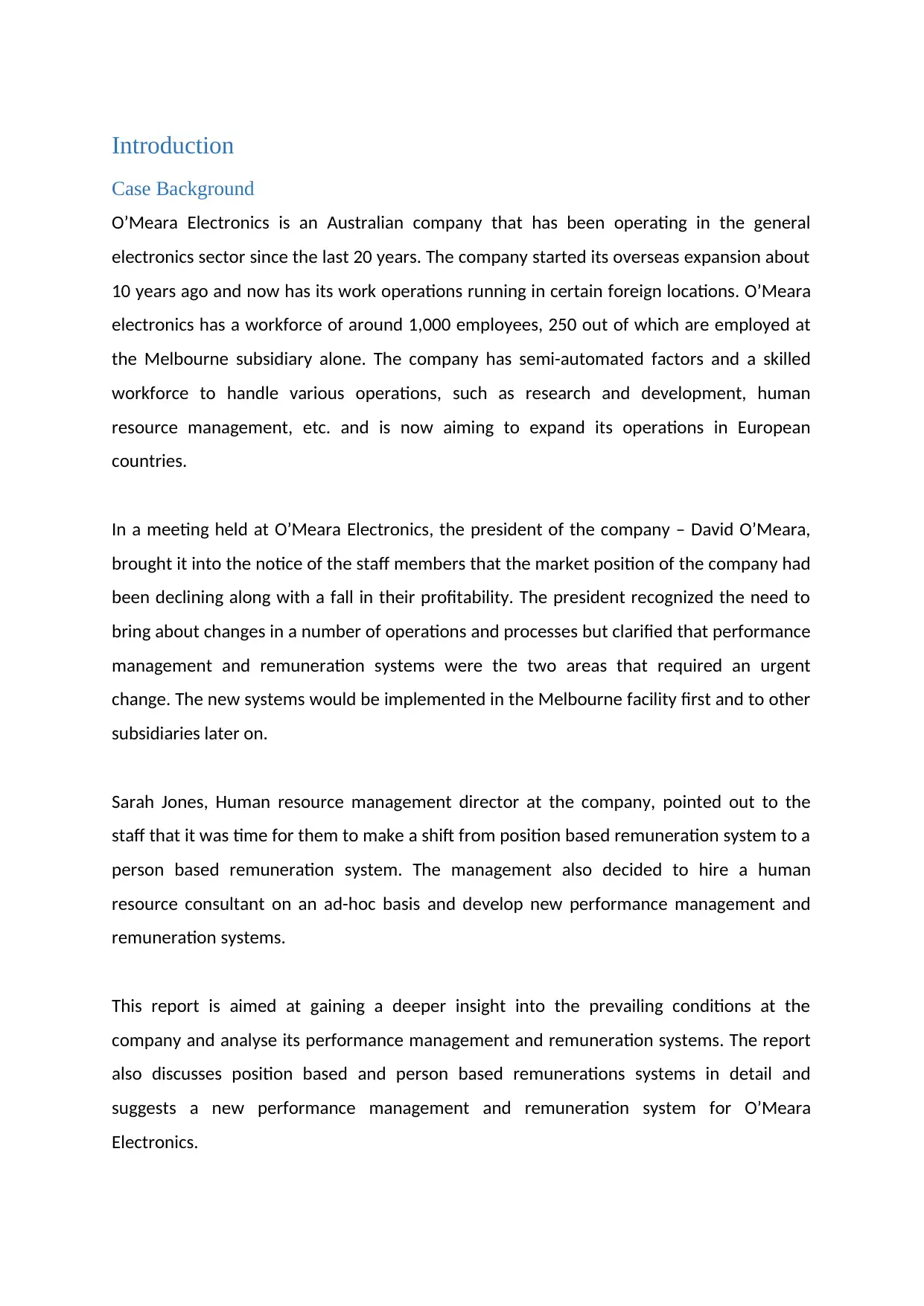
Introduction
Case Background
O’Meara Electronics is an Australian company that has been operating in the general
electronics sector since the last 20 years. The company started its overseas expansion about
10 years ago and now has its work operations running in certain foreign locations. O’Meara
electronics has a workforce of around 1,000 employees, 250 out of which are employed at
the Melbourne subsidiary alone. The company has semi-automated factors and a skilled
workforce to handle various operations, such as research and development, human
resource management, etc. and is now aiming to expand its operations in European
countries.
In a meeting held at O’Meara Electronics, the president of the company – David O’Meara,
brought it into the notice of the staff members that the market position of the company had
been declining along with a fall in their profitability. The president recognized the need to
bring about changes in a number of operations and processes but clarified that performance
management and remuneration systems were the two areas that required an urgent
change. The new systems would be implemented in the Melbourne facility first and to other
subsidiaries later on.
Sarah Jones, Human resource management director at the company, pointed out to the
staff that it was time for them to make a shift from position based remuneration system to a
person based remuneration system. The management also decided to hire a human
resource consultant on an ad-hoc basis and develop new performance management and
remuneration systems.
This report is aimed at gaining a deeper insight into the prevailing conditions at the
company and analyse its performance management and remuneration systems. The report
also discusses position based and person based remunerations systems in detail and
suggests a new performance management and remuneration system for O’Meara
Electronics.
Case Background
O’Meara Electronics is an Australian company that has been operating in the general
electronics sector since the last 20 years. The company started its overseas expansion about
10 years ago and now has its work operations running in certain foreign locations. O’Meara
electronics has a workforce of around 1,000 employees, 250 out of which are employed at
the Melbourne subsidiary alone. The company has semi-automated factors and a skilled
workforce to handle various operations, such as research and development, human
resource management, etc. and is now aiming to expand its operations in European
countries.
In a meeting held at O’Meara Electronics, the president of the company – David O’Meara,
brought it into the notice of the staff members that the market position of the company had
been declining along with a fall in their profitability. The president recognized the need to
bring about changes in a number of operations and processes but clarified that performance
management and remuneration systems were the two areas that required an urgent
change. The new systems would be implemented in the Melbourne facility first and to other
subsidiaries later on.
Sarah Jones, Human resource management director at the company, pointed out to the
staff that it was time for them to make a shift from position based remuneration system to a
person based remuneration system. The management also decided to hire a human
resource consultant on an ad-hoc basis and develop new performance management and
remuneration systems.
This report is aimed at gaining a deeper insight into the prevailing conditions at the
company and analyse its performance management and remuneration systems. The report
also discusses position based and person based remunerations systems in detail and
suggests a new performance management and remuneration system for O’Meara
Electronics.
⊘ This is a preview!⊘
Do you want full access?
Subscribe today to unlock all pages.

Trusted by 1+ million students worldwide
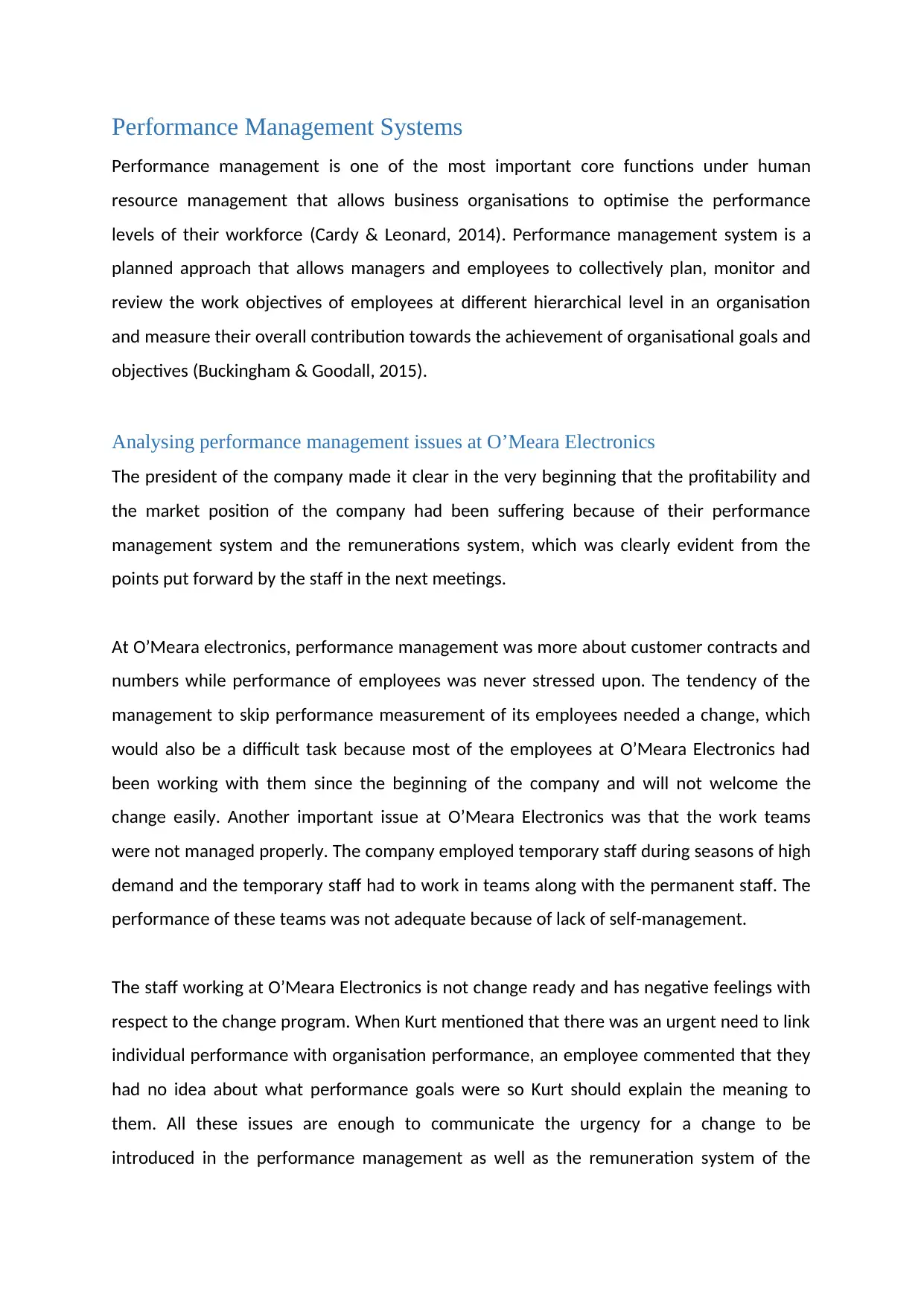
Performance Management Systems
Performance management is one of the most important core functions under human
resource management that allows business organisations to optimise the performance
levels of their workforce (Cardy & Leonard, 2014). Performance management system is a
planned approach that allows managers and employees to collectively plan, monitor and
review the work objectives of employees at different hierarchical level in an organisation
and measure their overall contribution towards the achievement of organisational goals and
objectives (Buckingham & Goodall, 2015).
Analysing performance management issues at O’Meara Electronics
The president of the company made it clear in the very beginning that the profitability and
the market position of the company had been suffering because of their performance
management system and the remunerations system, which was clearly evident from the
points put forward by the staff in the next meetings.
At O’Meara electronics, performance management was more about customer contracts and
numbers while performance of employees was never stressed upon. The tendency of the
management to skip performance measurement of its employees needed a change, which
would also be a difficult task because most of the employees at O’Meara Electronics had
been working with them since the beginning of the company and will not welcome the
change easily. Another important issue at O’Meara Electronics was that the work teams
were not managed properly. The company employed temporary staff during seasons of high
demand and the temporary staff had to work in teams along with the permanent staff. The
performance of these teams was not adequate because of lack of self-management.
The staff working at O’Meara Electronics is not change ready and has negative feelings with
respect to the change program. When Kurt mentioned that there was an urgent need to link
individual performance with organisation performance, an employee commented that they
had no idea about what performance goals were so Kurt should explain the meaning to
them. All these issues are enough to communicate the urgency for a change to be
introduced in the performance management as well as the remuneration system of the
Performance management is one of the most important core functions under human
resource management that allows business organisations to optimise the performance
levels of their workforce (Cardy & Leonard, 2014). Performance management system is a
planned approach that allows managers and employees to collectively plan, monitor and
review the work objectives of employees at different hierarchical level in an organisation
and measure their overall contribution towards the achievement of organisational goals and
objectives (Buckingham & Goodall, 2015).
Analysing performance management issues at O’Meara Electronics
The president of the company made it clear in the very beginning that the profitability and
the market position of the company had been suffering because of their performance
management system and the remunerations system, which was clearly evident from the
points put forward by the staff in the next meetings.
At O’Meara electronics, performance management was more about customer contracts and
numbers while performance of employees was never stressed upon. The tendency of the
management to skip performance measurement of its employees needed a change, which
would also be a difficult task because most of the employees at O’Meara Electronics had
been working with them since the beginning of the company and will not welcome the
change easily. Another important issue at O’Meara Electronics was that the work teams
were not managed properly. The company employed temporary staff during seasons of high
demand and the temporary staff had to work in teams along with the permanent staff. The
performance of these teams was not adequate because of lack of self-management.
The staff working at O’Meara Electronics is not change ready and has negative feelings with
respect to the change program. When Kurt mentioned that there was an urgent need to link
individual performance with organisation performance, an employee commented that they
had no idea about what performance goals were so Kurt should explain the meaning to
them. All these issues are enough to communicate the urgency for a change to be
introduced in the performance management as well as the remuneration system of the
Paraphrase This Document
Need a fresh take? Get an instant paraphrase of this document with our AI Paraphraser

company. Let us now discuss certain strategies that can be helpful for the company to deal
with its human resource management issues.
New performance management strategies
Performance management systems, if correctly developed, can pave the way for a company
towards achieving a huge success in the market. There are a number of performance
management systems that can be used in case of O’Meara electronics but the systems
discussed below will prove to be highly advantageous for the company:
Management by Objectives Management by objectives, also known as MBO, is one of
the most widely used performance management systems, which was developed by Peter
Drucker in 1954. In this system of performance management, an organisation aims at
improving the performance of its employees by collectively establishing objectives that are
agreed upon by the managers as well as the employees (Carmen, 2014).
Management by Objectives can have a number of benefits for a business organisation. The
process is divided into four steps, with the first step being the revision and establishment of
clear organisational objectives for the entire company by considering the mission and vision
statements (P., Rinkoo, & G., 2007). The second step in MBO involves setting up of SMART
goals, which translates to Specific, Measurable, Acceptable, Realistic, Time-bound. The goals
established in this process are the ones that are achievable for the employees and can be
measured in a specific period of time, which increases the efficiency of the system. The third
step is to involve the entire organisation in setting up of goals for all individuals (Murphy,
Cleveland, & Hanscom., 2018). This helps in engaging and motivating the employees in the
performance management system. The last step in this system is to evaluate and reward
the performance levels demonstrated by the employees.
Management by Objectives is widely used in the business world because of a number of
reasons. First of all, it lays stress upon creating of performance goals that are achievable and
realistic (SOCIETY FOR HUMAN RESOURCE MANAGEMENT , 2014). The process also stresses
upon the need of rewarding the employees for their performance levels rather than
punishing them for not achieving the desired performance objectives. Therefore,
with its human resource management issues.
New performance management strategies
Performance management systems, if correctly developed, can pave the way for a company
towards achieving a huge success in the market. There are a number of performance
management systems that can be used in case of O’Meara electronics but the systems
discussed below will prove to be highly advantageous for the company:
Management by Objectives Management by objectives, also known as MBO, is one of
the most widely used performance management systems, which was developed by Peter
Drucker in 1954. In this system of performance management, an organisation aims at
improving the performance of its employees by collectively establishing objectives that are
agreed upon by the managers as well as the employees (Carmen, 2014).
Management by Objectives can have a number of benefits for a business organisation. The
process is divided into four steps, with the first step being the revision and establishment of
clear organisational objectives for the entire company by considering the mission and vision
statements (P., Rinkoo, & G., 2007). The second step in MBO involves setting up of SMART
goals, which translates to Specific, Measurable, Acceptable, Realistic, Time-bound. The goals
established in this process are the ones that are achievable for the employees and can be
measured in a specific period of time, which increases the efficiency of the system. The third
step is to involve the entire organisation in setting up of goals for all individuals (Murphy,
Cleveland, & Hanscom., 2018). This helps in engaging and motivating the employees in the
performance management system. The last step in this system is to evaluate and reward
the performance levels demonstrated by the employees.
Management by Objectives is widely used in the business world because of a number of
reasons. First of all, it lays stress upon creating of performance goals that are achievable and
realistic (SOCIETY FOR HUMAN RESOURCE MANAGEMENT , 2014). The process also stresses
upon the need of rewarding the employees for their performance levels rather than
punishing them for not achieving the desired performance objectives. Therefore,
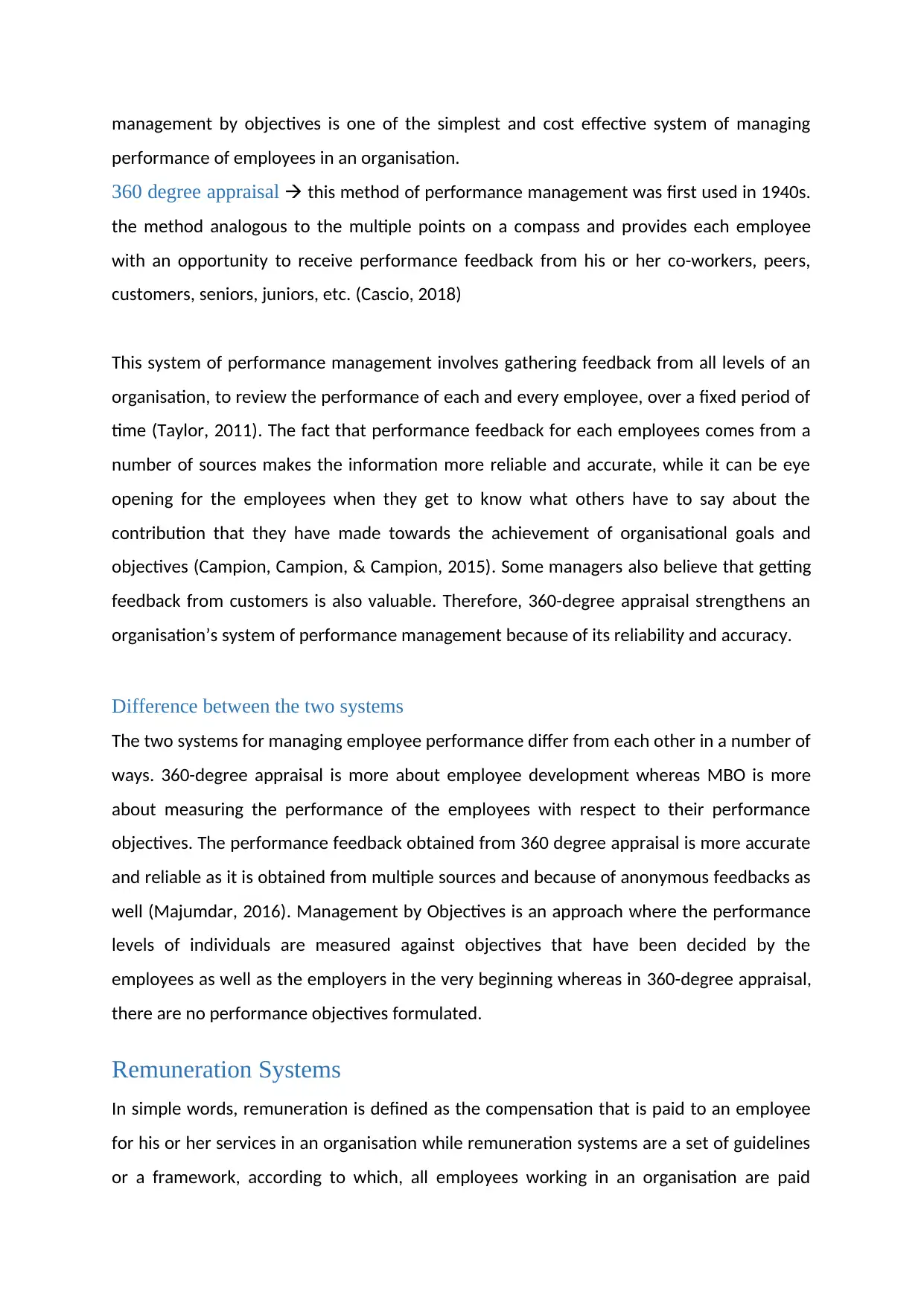
management by objectives is one of the simplest and cost effective system of managing
performance of employees in an organisation.
360 degree appraisal this method of performance management was first used in 1940s.
the method analogous to the multiple points on a compass and provides each employee
with an opportunity to receive performance feedback from his or her co-workers, peers,
customers, seniors, juniors, etc. (Cascio, 2018)
This system of performance management involves gathering feedback from all levels of an
organisation, to review the performance of each and every employee, over a fixed period of
time (Taylor, 2011). The fact that performance feedback for each employees comes from a
number of sources makes the information more reliable and accurate, while it can be eye
opening for the employees when they get to know what others have to say about the
contribution that they have made towards the achievement of organisational goals and
objectives (Campion, Campion, & Campion, 2015). Some managers also believe that getting
feedback from customers is also valuable. Therefore, 360-degree appraisal strengthens an
organisation’s system of performance management because of its reliability and accuracy.
Difference between the two systems
The two systems for managing employee performance differ from each other in a number of
ways. 360-degree appraisal is more about employee development whereas MBO is more
about measuring the performance of the employees with respect to their performance
objectives. The performance feedback obtained from 360 degree appraisal is more accurate
and reliable as it is obtained from multiple sources and because of anonymous feedbacks as
well (Majumdar, 2016). Management by Objectives is an approach where the performance
levels of individuals are measured against objectives that have been decided by the
employees as well as the employers in the very beginning whereas in 360-degree appraisal,
there are no performance objectives formulated.
Remuneration Systems
In simple words, remuneration is defined as the compensation that is paid to an employee
for his or her services in an organisation while remuneration systems are a set of guidelines
or a framework, according to which, all employees working in an organisation are paid
performance of employees in an organisation.
360 degree appraisal this method of performance management was first used in 1940s.
the method analogous to the multiple points on a compass and provides each employee
with an opportunity to receive performance feedback from his or her co-workers, peers,
customers, seniors, juniors, etc. (Cascio, 2018)
This system of performance management involves gathering feedback from all levels of an
organisation, to review the performance of each and every employee, over a fixed period of
time (Taylor, 2011). The fact that performance feedback for each employees comes from a
number of sources makes the information more reliable and accurate, while it can be eye
opening for the employees when they get to know what others have to say about the
contribution that they have made towards the achievement of organisational goals and
objectives (Campion, Campion, & Campion, 2015). Some managers also believe that getting
feedback from customers is also valuable. Therefore, 360-degree appraisal strengthens an
organisation’s system of performance management because of its reliability and accuracy.
Difference between the two systems
The two systems for managing employee performance differ from each other in a number of
ways. 360-degree appraisal is more about employee development whereas MBO is more
about measuring the performance of the employees with respect to their performance
objectives. The performance feedback obtained from 360 degree appraisal is more accurate
and reliable as it is obtained from multiple sources and because of anonymous feedbacks as
well (Majumdar, 2016). Management by Objectives is an approach where the performance
levels of individuals are measured against objectives that have been decided by the
employees as well as the employers in the very beginning whereas in 360-degree appraisal,
there are no performance objectives formulated.
Remuneration Systems
In simple words, remuneration is defined as the compensation that is paid to an employee
for his or her services in an organisation while remuneration systems are a set of guidelines
or a framework, according to which, all employees working in an organisation are paid
⊘ This is a preview!⊘
Do you want full access?
Subscribe today to unlock all pages.

Trusted by 1+ million students worldwide

according to their position or the skills that they possess (Vermeulen, 2011). The
remuneration system used in the business world can vary from one company to another and
a company can establish its own remuneration system as long as it complies with the laws of
the country in which it operates (Bosînceanu, 2008). In general, there are two basic
remuneration systems that are used by business organisation:
Position based remuneration system in this type remuneration system, the position that
an employee holds in the hierarchical level of an organisation forms the basis of his or pay
structure (Shields, et al., 2015). Apart from the position, the roles and responsibilities that a
person plays in an organisation is also considered while deciding his or her pay scale.
Person based remuneration system in this type of remuneration system, the skills or the
knowledge possessed by an employee is given a greater importance in deciding his or her
pay scale. This is a modern approach of deciding the salaries of employees because
companies have started looking for those employees who can add value to their business
because of their exceptional skills and knowledge.
A system for O’Meara Electronics
O’Meara electronics is a multinational company and is operating in a tough environment
where the competition between rival firms is high. The company had never experienced
workplace changes since its foundation, which will definitely make it difficult for the
management to bring changes to their remuneration and performance management
systems.
One of the best strategy that the management at O’Meara electronics can use is to combine
its remuneration system with its performance management system and use a mix of person
based and position based system (SFA, 2016). The management of the company can fix the
salaries of its employees on the basis of their positions and offer them a compensation that
is in accordance with the market trends. Further, the benefits or the rewards given to an
employee should be dependent on the performance that they demonstrate over a period of
time. Linking rewards with performance will prove to be one of the best ways to motivate
the employees to use their skills and knowledge and contribute best of their efforts towards
remuneration system used in the business world can vary from one company to another and
a company can establish its own remuneration system as long as it complies with the laws of
the country in which it operates (Bosînceanu, 2008). In general, there are two basic
remuneration systems that are used by business organisation:
Position based remuneration system in this type remuneration system, the position that
an employee holds in the hierarchical level of an organisation forms the basis of his or pay
structure (Shields, et al., 2015). Apart from the position, the roles and responsibilities that a
person plays in an organisation is also considered while deciding his or her pay scale.
Person based remuneration system in this type of remuneration system, the skills or the
knowledge possessed by an employee is given a greater importance in deciding his or her
pay scale. This is a modern approach of deciding the salaries of employees because
companies have started looking for those employees who can add value to their business
because of their exceptional skills and knowledge.
A system for O’Meara Electronics
O’Meara electronics is a multinational company and is operating in a tough environment
where the competition between rival firms is high. The company had never experienced
workplace changes since its foundation, which will definitely make it difficult for the
management to bring changes to their remuneration and performance management
systems.
One of the best strategy that the management at O’Meara electronics can use is to combine
its remuneration system with its performance management system and use a mix of person
based and position based system (SFA, 2016). The management of the company can fix the
salaries of its employees on the basis of their positions and offer them a compensation that
is in accordance with the market trends. Further, the benefits or the rewards given to an
employee should be dependent on the performance that they demonstrate over a period of
time. Linking rewards with performance will prove to be one of the best ways to motivate
the employees to use their skills and knowledge and contribute best of their efforts towards
Paraphrase This Document
Need a fresh take? Get an instant paraphrase of this document with our AI Paraphraser

the achievement of organisational goals and objectives. For measuring the performance of
the employees, the company can use management by objectives approach because it can be
directly linked with the present goals of the organisation and will also help in keeping the
employees engaged and motivated, which will further help the management in minimising
the resistance that the employees might offer to the change program.
Conclusion
The modern day business world has become very tough for companies like O’Meara
electronics that are operating on a multinational scale. In such a scenario, failure of a
performance management and remuneration system can be a blow to the market position
of a company. As a result, it is important for the management of the company to create an
urgency and bring about changes in its performance management system and remuneration
system. To achieve the organisational goals and objectives described by the president of the
company in the very first meeting, it becomes imperative for the management of the
company to link its performance management system and remuneration system together,
so that the employees can be motivated to perform better and contribute more towards the
achievement of organisational goals and objectives.
the employees, the company can use management by objectives approach because it can be
directly linked with the present goals of the organisation and will also help in keeping the
employees engaged and motivated, which will further help the management in minimising
the resistance that the employees might offer to the change program.
Conclusion
The modern day business world has become very tough for companies like O’Meara
electronics that are operating on a multinational scale. In such a scenario, failure of a
performance management and remuneration system can be a blow to the market position
of a company. As a result, it is important for the management of the company to create an
urgency and bring about changes in its performance management system and remuneration
system. To achieve the organisational goals and objectives described by the president of the
company in the very first meeting, it becomes imperative for the management of the
company to link its performance management system and remuneration system together,
so that the employees can be motivated to perform better and contribute more towards the
achievement of organisational goals and objectives.
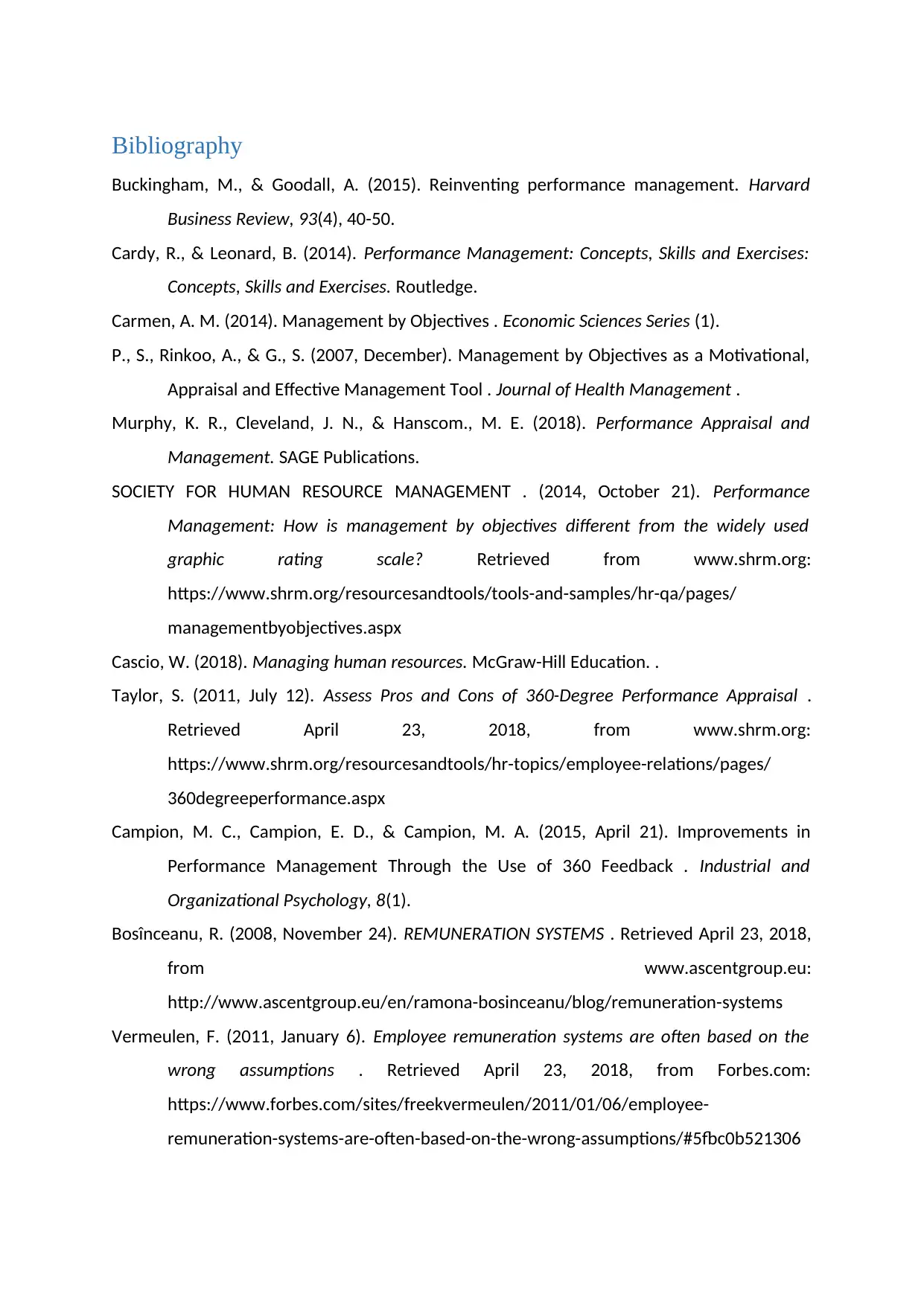
Bibliography
Buckingham, M., & Goodall, A. (2015). Reinventing performance management. Harvard
Business Review, 93(4), 40-50.
Cardy, R., & Leonard, B. (2014). Performance Management: Concepts, Skills and Exercises:
Concepts, Skills and Exercises. Routledge.
Carmen, A. M. (2014). Management by Objectives . Economic Sciences Series (1).
P., S., Rinkoo, A., & G., S. (2007, December). Management by Objectives as a Motivational,
Appraisal and Effective Management Tool . Journal of Health Management .
Murphy, K. R., Cleveland, J. N., & Hanscom., M. E. (2018). Performance Appraisal and
Management. SAGE Publications.
SOCIETY FOR HUMAN RESOURCE MANAGEMENT . (2014, October 21). Performance
Management: How is management by objectives different from the widely used
graphic rating scale? Retrieved from www.shrm.org:
https://www.shrm.org/resourcesandtools/tools-and-samples/hr-qa/pages/
managementbyobjectives.aspx
Cascio, W. (2018). Managing human resources. McGraw-Hill Education. .
Taylor, S. (2011, July 12). Assess Pros and Cons of 360-Degree Performance Appraisal .
Retrieved April 23, 2018, from www.shrm.org:
https://www.shrm.org/resourcesandtools/hr-topics/employee-relations/pages/
360degreeperformance.aspx
Campion, M. C., Campion, E. D., & Campion, M. A. (2015, April 21). Improvements in
Performance Management Through the Use of 360 Feedback . Industrial and
Organizational Psychology, 8(1).
Bosînceanu, R. (2008, November 24). REMUNERATION SYSTEMS . Retrieved April 23, 2018,
from www.ascentgroup.eu:
http://www.ascentgroup.eu/en/ramona-bosinceanu/blog/remuneration-systems
Vermeulen, F. (2011, January 6). Employee remuneration systems are often based on the
wrong assumptions . Retrieved April 23, 2018, from Forbes.com:
https://www.forbes.com/sites/freekvermeulen/2011/01/06/employee-
remuneration-systems-are-often-based-on-the-wrong-assumptions/#5fbc0b521306
Buckingham, M., & Goodall, A. (2015). Reinventing performance management. Harvard
Business Review, 93(4), 40-50.
Cardy, R., & Leonard, B. (2014). Performance Management: Concepts, Skills and Exercises:
Concepts, Skills and Exercises. Routledge.
Carmen, A. M. (2014). Management by Objectives . Economic Sciences Series (1).
P., S., Rinkoo, A., & G., S. (2007, December). Management by Objectives as a Motivational,
Appraisal and Effective Management Tool . Journal of Health Management .
Murphy, K. R., Cleveland, J. N., & Hanscom., M. E. (2018). Performance Appraisal and
Management. SAGE Publications.
SOCIETY FOR HUMAN RESOURCE MANAGEMENT . (2014, October 21). Performance
Management: How is management by objectives different from the widely used
graphic rating scale? Retrieved from www.shrm.org:
https://www.shrm.org/resourcesandtools/tools-and-samples/hr-qa/pages/
managementbyobjectives.aspx
Cascio, W. (2018). Managing human resources. McGraw-Hill Education. .
Taylor, S. (2011, July 12). Assess Pros and Cons of 360-Degree Performance Appraisal .
Retrieved April 23, 2018, from www.shrm.org:
https://www.shrm.org/resourcesandtools/hr-topics/employee-relations/pages/
360degreeperformance.aspx
Campion, M. C., Campion, E. D., & Campion, M. A. (2015, April 21). Improvements in
Performance Management Through the Use of 360 Feedback . Industrial and
Organizational Psychology, 8(1).
Bosînceanu, R. (2008, November 24). REMUNERATION SYSTEMS . Retrieved April 23, 2018,
from www.ascentgroup.eu:
http://www.ascentgroup.eu/en/ramona-bosinceanu/blog/remuneration-systems
Vermeulen, F. (2011, January 6). Employee remuneration systems are often based on the
wrong assumptions . Retrieved April 23, 2018, from Forbes.com:
https://www.forbes.com/sites/freekvermeulen/2011/01/06/employee-
remuneration-systems-are-often-based-on-the-wrong-assumptions/#5fbc0b521306
⊘ This is a preview!⊘
Do you want full access?
Subscribe today to unlock all pages.

Trusted by 1+ million students worldwide
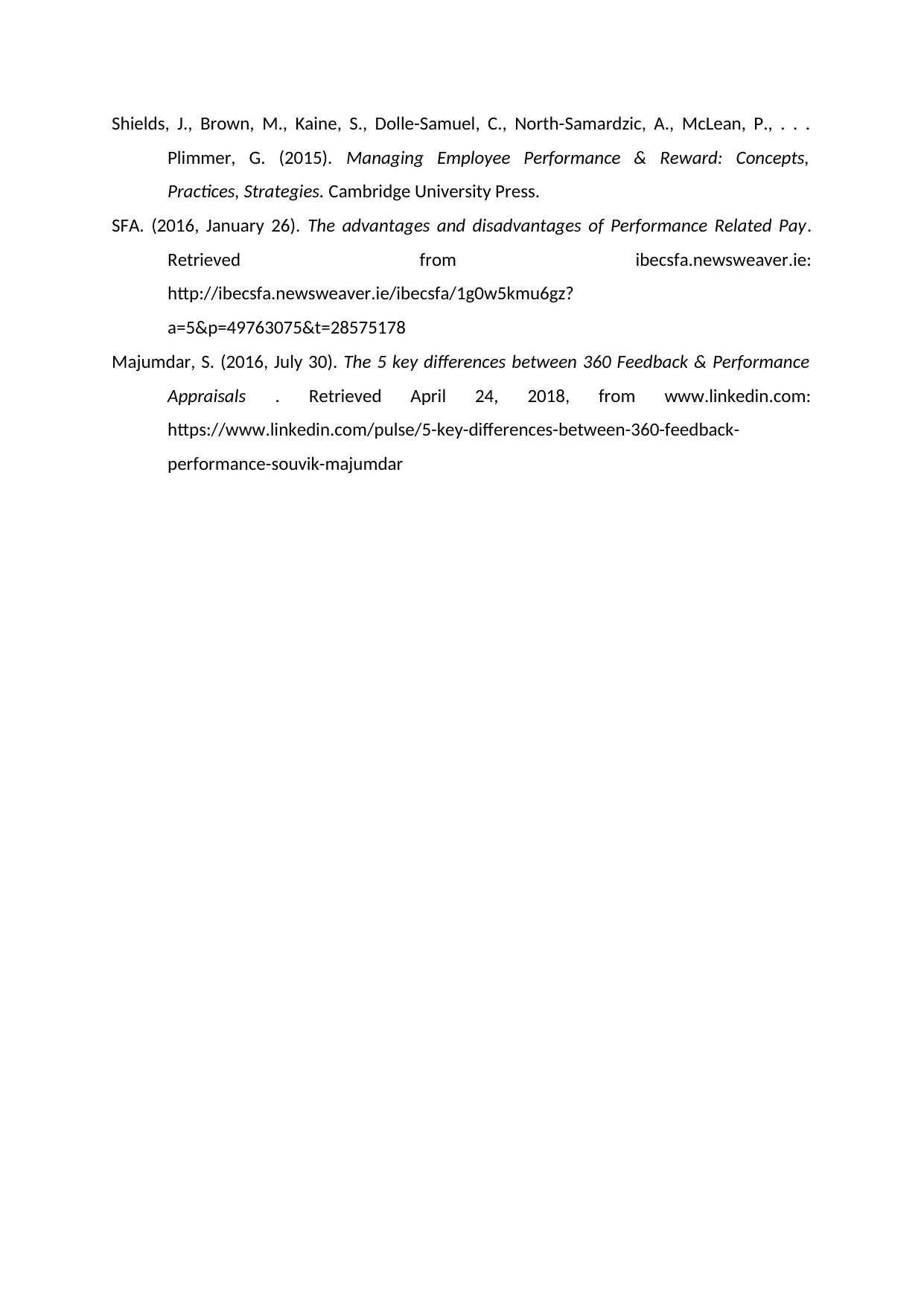
Shields, J., Brown, M., Kaine, S., Dolle-Samuel, C., North-Samardzic, A., McLean, P., . . .
Plimmer, G. (2015). Managing Employee Performance & Reward: Concepts,
Practices, Strategies. Cambridge University Press.
SFA. (2016, January 26). The advantages and disadvantages of Performance Related Pay.
Retrieved from ibecsfa.newsweaver.ie:
http://ibecsfa.newsweaver.ie/ibecsfa/1g0w5kmu6gz?
a=5&p=49763075&t=28575178
Majumdar, S. (2016, July 30). The 5 key differences between 360 Feedback & Performance
Appraisals . Retrieved April 24, 2018, from www.linkedin.com:
https://www.linkedin.com/pulse/5-key-differences-between-360-feedback-
performance-souvik-majumdar
Plimmer, G. (2015). Managing Employee Performance & Reward: Concepts,
Practices, Strategies. Cambridge University Press.
SFA. (2016, January 26). The advantages and disadvantages of Performance Related Pay.
Retrieved from ibecsfa.newsweaver.ie:
http://ibecsfa.newsweaver.ie/ibecsfa/1g0w5kmu6gz?
a=5&p=49763075&t=28575178
Majumdar, S. (2016, July 30). The 5 key differences between 360 Feedback & Performance
Appraisals . Retrieved April 24, 2018, from www.linkedin.com:
https://www.linkedin.com/pulse/5-key-differences-between-360-feedback-
performance-souvik-majumdar
1 out of 10
Related Documents
Your All-in-One AI-Powered Toolkit for Academic Success.
+13062052269
info@desklib.com
Available 24*7 on WhatsApp / Email
![[object Object]](/_next/static/media/star-bottom.7253800d.svg)
Unlock your academic potential
Copyright © 2020–2025 A2Z Services. All Rights Reserved. Developed and managed by ZUCOL.




